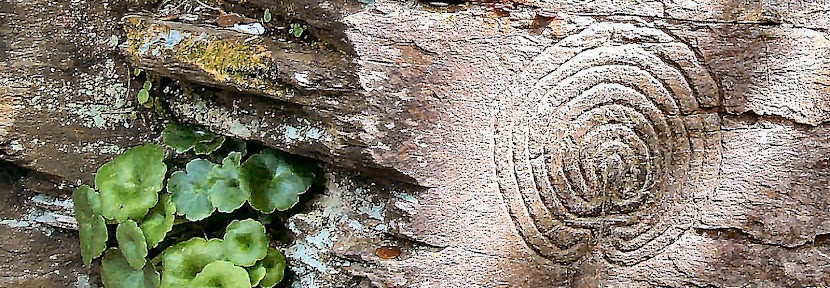Alex Langstone
The Roseland
peninsula is situated roughly midway along the southern Cornish shore and lies between
the Carrick Roads to the west and Mevagissey Bay in the east. The district
boasts pretty villages, sandy beaches and the small town of St Mawes, which
lies at mouth of the Percuil River. The small port is named after St Maudez, a
6th Century monk, who was popular in Brittany. [i]
He may have been Welsh or Irish and had one of his first settlements on the
south coast of Cornwall. The towns holy
well is named after the saint, and may have formed part of his hermitage, as
local lore claims that Maudez created a chair in the rock above the well. [ii]
The old well later became a wishing well, where pins were dropped into it to
gain favours. [iii]
At the other end of the peninsula lies the village of Veryan, where in the 19th century, vicar and local land owner Jeremiah Trist built the famous round house sentinels that guard the main road in and out of the village. They were built between 1815 and 1818 and each have a thatched roof crowned by a cross. The round nature of each building was described as ‘preventing the devil from entering the village, as there are no corners to hide in’.
There is a curious tradition connected
to Veryan parish church. It states that should the church clock strike on the
Sunday morning during the singing of the hymn before the sermon, or before the
‘collect against perils’ at Evening Prayer, there will be a death in the parish
before the following Sunday. [iv]
Just outside the village, around a mile or so lies Carne Beacon, a large Bronze Age barrow whose folkloric story lays claim to be the last resting place of King Gerennius. His body was brought across Gerrans Bay, from his castle at Dingerein, on a golden boat with silver oars, and both the boat, the oars and the king still wearing his crown were buried in the barrow.[v] Sadly, when Carne Beacon was excavated, only a cist with some cremated remains were discovered. Maybe they needed to dig deeper?
Nearby at Dingerein Castle hill fort lies the Mermaid’s Hole, a subterranean
passage, which was said to link the castle to the sea.[vi]
Possibly alluding to a lost tale or tradition. Folklorist Margaret Courtney had
this to say about the legend of Dingerein and the Mermaid’s Hole:
His palace of Dingerein
was in the neighbouring village of Gerrans. A subterranean passage, now known
as Mermaid's Hole, one day discovered when ploughing a field, was supposed to
have led from it to the sea.
There is a
cave below Penarrin Point [vii]
which is named after one of the most famous sons of Cornish folklore, Jan
Tregeagle, and when storms rage across this part of the Roseland coast, it is
blamed on Tregeagle’s spirit, which haunts the cave and conjures storms in
league with the devil himself.
Just to the north of Veryan, lies the hamlet of Bessy Beneath,
where oral tradition concludes that either a witch or highwaywoman was hanged
and buried at the crossroads. However, the name may possibly be an English
corruption of the Cornish bosveneth
meaning a hillside dwelling [viii]
The ancient crossing at King Harry Ferry has an interesting tale associated with its founding. It was often repeated in days gone by that King Hal crossed the river at this spot with his queen on his back. The river here is several fathoms deep, so King Hal must have been a giant to be able to afford this great feat. Those that cross here today, will recall that just upstream of the ferry, mighty ocean-going ships are often laid up for repair, confirming how deep the river is at this particular crossing.
The old church at St Anthony, not far from the lighthouse, at the sea ward end of the peninsula, lies close to where the former priory of St Mary de Vale once stood. The site of the Priory is cursed. It was the last prior who laid the curse upon the site, after Henry VIII visited and told him that the priory and its surrounding lands days were numbered. The curse stated that the new owner and his family would all die prematurely. The new holder of the lands died soon after he took over, and so did all his family.[ix]
[i]
The Saints of Cornwall by Catherine Rachel John, p 54
[ii]
Ancient and Holy Wells by L & M Quiller Couch p 147
[iii]
Ibid p 150
[iv] Cornish
Feasts and Folklore by M A Courtney, p 102
[v]
Popular Romances of the West of England by Robert Hunt, p 459
[vi]
Cornish Feasts and Folklore by M A Courtney, p 103
[vii]
The Folklore of Cornwall by Deane and Shaw p 84
[viii]
A Concise Dictionary of Cornish Place-Names by Craig Weatherhill
[ix] Cornish
Feasts and Folklore by M A Courtney, p 102


















